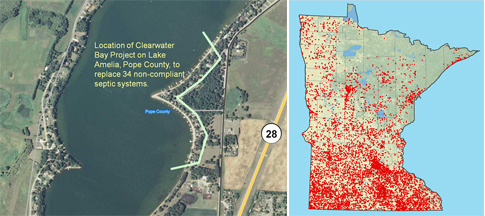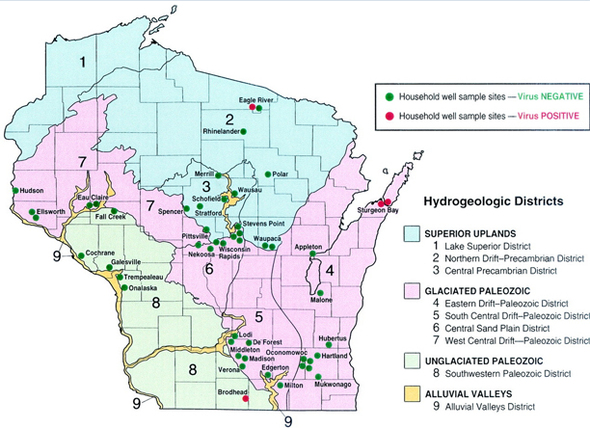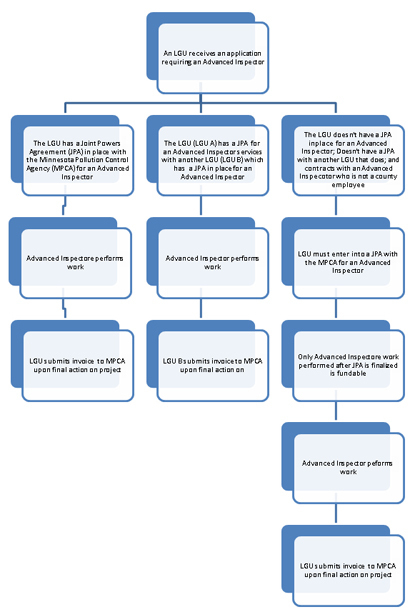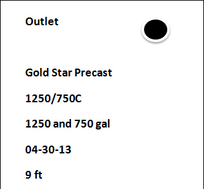|
As counties and other local units of government across the state step-up their efforts to identify and assess all of the SSTS within their jurisdictions, the need to help residents find ways to finance required upgrades is becoming increasingly important. One of those potential sources of funding is the Minnesota AgBMP Loan Program available through the Minnesota Department of Agriculture.
This program provides 3% interest loans to farmers and rural landowners for efforts that help improve water quality.
David Miller with the MDA says many people have a misconception that the AgBMP Loan Program is only for farmers but points out that 58 percent of the loans provided for SSTS projects have gone to non-farming households and businesses. "Any rural landowner is eligible," Miller says. "We have done loans for projects ranging from upgrading an outhouse to a $600,000 multi-connection system. We have done homes, farms, resorts, churches, gas stations, businesses, cabins, and many other types of systems. If the borrower qualifies for a loan, we will fund the project," Miller says. He mentions cases ranging from an elderly woman with limited funds who lives alone who was able to replace her failing septic system to a large project that replaced 34 septic systems around Lake Amelia in Pope County with a cluster system.
Miller said the amount of money going to SSTS projects is going up due to counties conducting SSTS inventory projects and increasing participation by local lenders.
How the AgBMP Loan Program works
The borrower proposes a project to the local soil and water conservation districts or county environmental offices. If the borrower meets state eligibility requirements and the project addresses local water quality priorities, the county approves the project and directs them to a cooperating local lender. The local lender evaluates the financial aspects of the project. With approval of the county and local lender, the project is implemented, the funds are provided by the MDA to the local lender, and the lender issues the loan.
Statistics for AgBMP septic loans issued in the last five years
- Total amount: $14.4 million
- Total number: 1,446
- Average loan for mound System: $12,183 72% of systems installed
- Average loan In ground systems: $9,030 28% of systems installed
Since 1995, a total of $75 million has been made available through the federal Clean Water Act and the Minnesota Legislature, funding over 11,000 projects. For more information, visit the MDA BMP loan website.
Below left, a map of the septic system replacement project on Lake Amelia in Pope County. Below right, a distribution map of AgBMP loans in the state.

By Mark Wespetal
MPCA staff recently attended the spring conference of the Minnesota Ground Water Association where the theme was Hydrogeology and the Public Health. One of the more notable presentations discussed viruses in groundwater. This topic is directly related to SSTS as sewage contains enteric viruses and SSTSs discharge sewage into the groundwater. SSTS design elements- vertical separation distance, gravelly soil limits and light loading rates – are all based on removal of viruses in the sewage.
The presenter -- Mark Borchardt of Marshfield, Wisc., described viruses as follows
- they are non-living packets of protein and nucleic acid,
- they are host specific,
- they are very small,
- they are negatively charged and can be transported through soil
Borchardt said there is ample evidence groundwater contains viruses (contrary to the common belief that ground water is pure and pristine), and that these viruses have caused illnesses. These viruses have come from human fecal matter.
The research project sampled drinking water from household taps. Surprisingly, 24% of all samples were virus-positive with 3% of samples positive for more than one virus type. The research also surveyed the health of the residents. The data shows a significant increase in gastrointestinal illness when viruses were present. They concluded that about 22% of gastrointestinal illness of the residents in the study was due to viruses in drinking water.
Another surprising finding is that type and concentrations of viruses in groundwater greatly vary over time.
Borchardt described an outbreak of illness caused by viruses at a restaurant in Door County Wisconsin. The restaurant had a new, code-compliant SSTS. However, a supply pipe had broken (or came loose) and was point-loading the soil with sewage. The soil/hydro setting was shallow soils over creviced dolomite. Dye tracing indicated sewage from the leaking pipe reached the restaurant’s water supply well in six days. Virus transport was also documented at private wells downgradient of the restaurant.
The presentation by Dr. Borchardt and others at the conference once again brought-to-light, and was an excellent reminder of, the importance of the work of the SSTS industry. More information on Dr. Borchardt's research on viruses and groundwater can be found online. Below is a map excerpted from the study.

 By Gretchen Sabel
Grants are now
available to provide counties with compensation for 75% of the cost to
review new and replacement SSTS with design flow of 2,500 gallons per
day or more. Funds for this grant were made possible by the Clean Water
Legacy Act to protect groundwater and surface
water from impacts resulting from the improper design and/or
construction of subsurface sewage treatment systems.
The support will be
provided through a Joint Powers Agreement (JPA) which is executed
between the MPCA and an interested county. The Advanced Inspector may
be a Qualified Employee Advanced Inspector of the county where the work
is occurring, a Qualified Employee Advanced Inspector of another local
unit of government working through an agreement between the local
governments, or a private Advanced Inspector under contract with the
county. (Qualified Employees are individuals who are certified in a
specific license area by the MPCA and then employed by a local unit of
government.)
These funds
are available to counties to support their work in regulating systems
that require that an Advanced Inspector perform the review, inspection,
and permitting of new SSTS systems with a design flow of 2,500 gallons
per day or more. For more information, please check the MPCA website .
The first step in the process
to receive financial assistance is to have a JPA in
place. Only work completed by an Advanced Inspector after a JPA has
been executed with the MPCA is eligible for funding. Once a JPA has been
fully executed, it will cover any number of projects completed during
the effective period. Each project does not require a new JPA. Upon
completion of each individual project, the county submits a pay
request. No pre-approval or application is required other than the
JPA. The chart below shows the process once the JPA has been
executed.
Gretchen Sabel is the MPCA project manager for this new grant. Take a look at the information
on the MPCA webpage and talk with others in your county to determine
whether your county would like to participate in this program.
|

|
As of Jan. 1, 2013, the following labeling requirements apply to all sewage tanks registered in Minnesota.
- Either the inlet or the outlet must be clearly marked on each tank
- Near the tank outlet (on the top or side of the tank), each tank shall be marked with the following:
- Manufacturer’s name
- Model number
- Liquid capacity (gallons)
- Date of manufacture
- Maximum depth of burial
|
|
 |
|